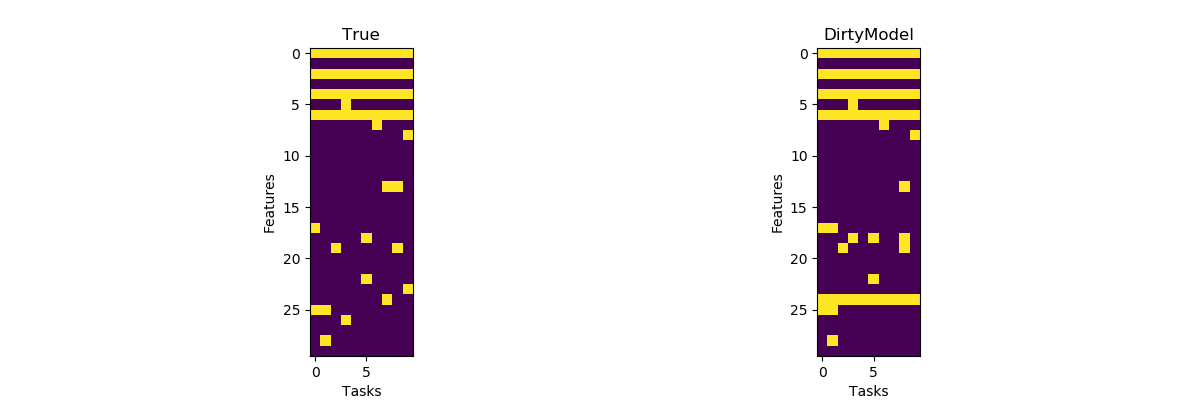Note
Click here to download the full example code
Joint feature selection with Dirty models¶
DirtyModel estimates a set of sparse coefficients for multiple regression models that share a fraction of non-zero features. It is a generalization of The GroupLasso estimator. It also takes a 3D X (n_tasks, n_samples, n_features) and a 2D y (n_tasks, n_samples).
DirtyModel solves the optimization problem:
(1 / (2 * n_samples)) * ||Y - X(W_1 + W_2)||^2_Fro + alpha * ||W_1||_21
+ beta * ||W_2||_1
Where:
||W||_21 = \sum_i \sqrt{\sum_j w_ij^2}
i.e. the sum of norm of each row. and:
||W||_1 = \sum_i \sum_j |w_ij|
# Author: Hicham Janati (hicham.janati@inria.fr)
#
# License: BSD (3-clause)
import numpy as np
from matplotlib import pyplot as plt
from mutar import DirtyModel
Generate multi-task data
rng = np.random.RandomState(42)
n_tasks, n_samples, n_features = 10, 100, 30
X = rng.randn(n_tasks, n_samples, n_features)
# generate random coefficients and make it sparse
# select support
support = rng.rand(n_features, n_tasks) > 0.95
coef = support * rng.randn(n_features, n_tasks)
# make features 0, 2, 4 and 6 shared
coef[:7:2] = rng.randn(4, n_tasks)
y = np.array([x.dot(c) for x, c in zip(X, coef.T)])
# add noise
y += 0.2 * np.std(y) + rng.randn(n_tasks, n_samples)
Dirty models fit
alpha = 0.5
beta = 0.25
dirty = DirtyModel(alpha=alpha, beta=beta)
dirty.fit(X, y)
Plot the supports of the true and obtained coefficients.
f, axes = plt.subplots(1, 2, figsize=(12, 4))
for ax, coef, name in zip(axes, [coef, dirty.coef_], ["True", "DirtyModel"]):
ax.imshow(coef != 0)
ax.set_title(name)
ax.set_xlabel("Tasks")
ax.set_ylabel("Features")
plt.show()

Estimated memory usage: 10 MB